History
Orava dam
Taming of Orava waters was already considering in the preceeding centuries. The first project of iron-concrete dam construction on present place was created in 1870. Also other projects were created, however the construction itself started to be considered seriously in the 30s of the 20th century in connection with water-agricultural utilization of the river Váh. Exploratory and geological works started during the summer in 1940. The dam construction started 11 Oct 1941. The work was slowed down by geological problems and lack of workers. Dam concreting started 1 Dec 1943. The construction stagnated after the war.During the years 1945-1948 mainly an extensive geological research was making. A lot of local and foreign specialists were working on the construction. A new project was made and the work continued. The first turbine started to function 2 May 1953. The dam construction continued to 1954. These villages have been flooded by the dam.
 Oravian Hamre
Oravian Hamre
The term Hamre refers to a technological building built near the river. Settlement foundations were established by the brothers Michal and Gál Hamerník-Závadovský. Juraj Thurzo enabled them to search and mine ironstone in a near settlement Stankova on the Jelešňa river. They could build their own hamre for iron near the mills of the founder Závadský. In 1617, inhabitants of Tvrdošín started complaining about decreasment of their estate because of hamre establishing on their meadows. Hamre belonged to Osada in this period. Juraj and Imrich Thurzo´s privileges from 1615 were confirmed by Gašpar Illésházy too. As their estate had grown, Gašpar Illésházy increased their taxes. However, he let them build a mill on the Jelešňa river. An iron workshop was established there in 1686, the brothers had to pay 60 florins every year. The settlement became poorer by decreasing of ore amount and in 1728 the settlement was registered as peasant, without hamres. Ecclesiastically, Hamre belonged to Trstená, later to the vicarage in Ústie. Mining of iron ore and its working in the plant could still be seen in 1837. Linen production was flourishing in this period. Proportion between nobility and common inhabitants was modified after serfdom abolition by the Agreement from 8.6.1865. Municipal seal is represented by an angel with upraised hands, who has three stars above his head.
 Osada
Osada
The first mention of the settlement comes from 1609. It is introduced under the name Zawada as new settlement in the tax register. In 1616 a landlord gave the soltys (village headman) privileges with one settlement, mill and sawmill to Jakub Ústiansky. He gave 6 homesteads to peasants. Cattle breeding was developed in the area and that´s why Thököly enabled the Osada inhabitants to make use of Kriváň Hill. The name Osada came into use before 1659 (before Zawada, Stankovo). The inhabitants were interested in agriculture and there were also three potters in the settlement. They were growing flax, which was used for quality thread production. Gradually, linen production and cattle trade started flourishing in the area. Ecclesiastically, Osada belonged to Trstená later to Ústie. Proportion between nobility and common inhabitants was modified after serfdom abolition by the Agreement from 23.4.1870. Municipal seal is represented by Madonna keeping child in her left hand while an iron in the right one.
 Slanica
Slanica
The village was established at the confluence of Slanica (present Polhoranka) and Biela Orava rivers by the Kľudovsky family members coming from Kňažia. The first mention comes from 1564 (Zlavycha). In 1566 the village was known as Zlanicza and in 1567 recognized under the name Slanicza. Low soil fertility caused that people were working in agriculture, cattle breeding and were growing and manufacturing flax. Flax seeds, flax, threads and mainly linen were sold in the all regions of the monarchy. The inhabitants of Slanica stayed in a servile state against Oravian nobility till 1848. Proportion between nobility and common inhabitants was modified by the Agreement from 14-15.5.1866. Before the municipality was flooded by Orava dam, it had had an area of 1200 hectares of agricultural soil. Municipal seal: two bushes with a bird over them. Number of inhabitants: 1785-819; 1825-894; 1880-967; 1910-794; 1930-829; 1940-805. Significant monuments: Slanica Island of Art with the chapel and expositions from Oravian gallery, the memorial of Anton Bernolák.
Proportion between nobility and common inhabitants was modified by the Agreement from 14-15.5.1866. Before the municipality was flooded by Orava dam, it had had an area of 1200 hectares of agricultural soil. Municipal seal: two bushes with a bird over them. Number of inhabitants: 1785-819; 1825-894; 1880-967; 1910-794; 1930-829; 1940-805. Significant monuments: Slanica Island of Art with the chapel and expositions from Oravian gallery, the memorial of Anton Bernolák.
Ústie
The settlement was established at the mouth of waters of White and Black Orava. The king Ferdinand expanded the rights given to Oravian shepherds also to settlements ´Wsthij et Bzijnij´ in 1550.  Besides shepherds, Katarína Zrínska mentioned also Ústie with 6 shepherd fields in 1575. The settlement was suffering a lot in the first decade of 17th century, it became totally desolated in 1608. A subsidiary church was established here in 1618. During the 18th century inhabitants were working in agriculture and linen trade. During the years 1754-1756 a brick church was built instead of the wooden one. Proportion between nobility and common inhabitants was modified by the Agreement from 15.5.1868. Municipal seal: three types of municipal seals are known. First is represented by a broadleaved tree with roots, around the letters S – P/U – S. Second one is represented by a tree growing from the sward, with U – S letters by the trunk. The third type is dated from 1828. It is represented by the spruce having a moon-star symbol in the treetop.
Besides shepherds, Katarína Zrínska mentioned also Ústie with 6 shepherd fields in 1575. The settlement was suffering a lot in the first decade of 17th century, it became totally desolated in 1608. A subsidiary church was established here in 1618. During the 18th century inhabitants were working in agriculture and linen trade. During the years 1754-1756 a brick church was built instead of the wooden one. Proportion between nobility and common inhabitants was modified by the Agreement from 15.5.1868. Municipal seal: three types of municipal seals are known. First is represented by a broadleaved tree with roots, around the letters S – P/U – S. Second one is represented by a tree growing from the sward, with U – S letters by the trunk. The third type is dated from 1828. It is represented by the spruce having a moon-star symbol in the treetop.


